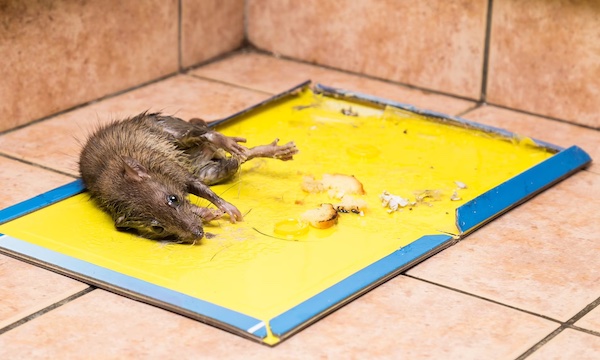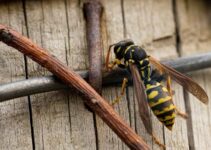Sticky or glue traps are made of adhesives designed to hold on to rodents firmly when stepped on. Mice usually die in this trap out of exhaustion among other things.
Their death may also be influenced by humans (a sharp blow to the head preferably) if found alive in the trap.

How do Mice Die on Sticky Traps?
While glue traps may seem effective, their method is questionable. They subject mice to unnecessary suffering and pain all in the name of rodent control.
A mouse stuck on a glue trap may die as a result of:
- Panic and heart attack – the shock of getting stuck and staying that way for days can kill a mouse.
- Suffocation – if the mouse’s nose eventually gets stuck. Death is quicker in this case.
- Starvation – mice may also die of starvation after days of being stuck in the trap without food or water.
- Death after an escape – Mice have been known to escape glue traps in a few cases but not every one of them survives after escaping. To escape a sticky trap, they either have to peel their skin or lose a limb or fur.
Are There Humane Ways to Catch A Mouse?
Glue traps are inhumane and illegal in some countries. If you are interested in better ways to capture mice, try any of these options:
Snap Traps
Snap traps have been around for years and remain one of the most humane methods to kill mice. All you need to set up this trap is baits like peanut butter or fruit jam. When placing baits, ensure you place them in the bait space.
Avoid touching the bait with your bare hands. You should also ensure the trap rests on a wall and wait for the snap sound. The beauty of snap traps is that they kill with just one strike. They are also very affordable and reusable (after being cleaned).
Electric Mouse Traps
Electric mouse traps are modern inventions and are a bit pricey. However, they are very effective and execute a neat job in serving mice painless death.
Unlike spring traps, they kill by sending volts through a mouse’s body. After every kill, all you need to do is open the lid and dump the mouse in the trash. They must be cleaned before reuse and have a safety button for when not in use.
Catch and Release Traps
If you value wildlife, catch and release traps such as cube and bucket traps are the best options for you. These traps capture mice alive by luring them into a box or buckets (or gallons) with baits.
Box traps have vents while bucket traps provide open space within the bucket. Like every trap, they must be checked regularly to properly release captured mice into the wild. Bucket traps can become inhumane if the bucket contains water.
Rodent-proofing Tips You Must Know
1. Eliminate Access To Food
Food attracts mice to your home. To control them, you must starve them. Starting them requires:
- Storing pet meals in strong or chew-proof containers.
- Keep your floors, tables, cabinets, counter surfaces, and kitchen areas free of food crumbles.
- Picking up fallen fruits and vegetables in your garden regularly. You should also keep the grasses and vegetation well-trimmed.
2. Repellents
Rodents can be repelled out of your property via ammonia-soaked rags and homemade concoctions (peppermint and clove). Locate their entry point and place these repellents there. Mice hate their smell and will vacate such spots.
Sonic emitters are also a form of repellent with proven records of controlling rodents. However, their mode of operation may affect pets like dogs and cats. Once you are confident all the mice in your home have fully repelled, seal all entry points to prevent them from returning.
Conclusion
Mice don’t die instantly on glue traps. They attempt to break free and suffer before they die. During this process, they may pee or defecate on your trap. Some may even lose blood.
This is why it is important to check on your trap regularly and dispose of the trap with a captured mouse the right way. Practices such as this reduce your chances of exposure to bacterial or viral disease.
References
- https://www.catseyepest.com/important-updates/facts-about-mouse-glue-traps/
- https://www.peta.org/action/steps-to-rescue-animals-from-glue-traps/
- https://www.automatictrap.com/blogs/news/how-do-sticky-traps-work
- https://www.cdc.gov/cdctv/healthyliving/hygiene/fight-germs-wash-hands.html
- https://www.orkin.com/rodents/mouse-control/how-mice-enter-homes/





